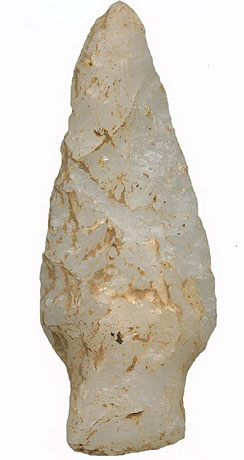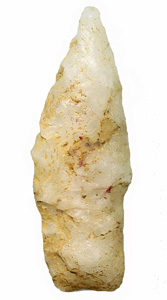



Point Type:
MERRIMACK
Also See: Bradley Spike, Dewart Stemmed, Duncan's Island, Dustin, Durst
Stemmed, Garver's Ferry, Lamoka
, Neville, Piney Island, Randolph,
Sandhill, Sylvan Lake, Swan Lake, Wading River
Location: New England States
Associated Dates: 6000 - 5000
B.P. -
Middle Archaic
Morphology:
Stemmed
General Description: The Merrimack
stemmed point type has a narrow trianguloid blade shape with
slightly convex blade edges while
straight blade edges are rare. The Merrimack
was a dart point. The shoulders in most specimens are neatly
executed but are small and can be well defined or rounded and often angle away
from the base. Some rare examples approach the stem at right
angles. The stems are long, wide
and well thinned and have parallel sides
on 72% of the specimens and slightly expanded stems on 18% of the specimens or
slightly contracting
stems
on 10% of the specimens. The base of the
stem is most often straight or slightly convex but never concave. Stem grinding is
most often present.
The Merrimack point type is the last of the
Neville complex of point types.
The size of the Merrimack
point ranges from 25 mm to 65 mm in length. The average size for the
point is in the 40 mm range.
The Merrimack type is
typically made from local materials principally cherts, quartz,
and quartzite as well as fine grained igneous rocks.
The Merrimack can be found in
Massachusetts, all of southern New England into Vermont and
New Hampshire, Connecticut and down into southern New York, northern New
Jersey and eastern Pennsylvania.
The Merrimack type was named by Dena Dincauze in 1976
for points found at the Neville site in Amoskeg, at the Merrimack River,
Manchester, New Hampshire.
NOTE: Merrimack
points that have been resharpened will result in specimens with shorter and
narrower blades than they had when they were in as new condition. The
shoulders on these resharpened specimens will be greatly diminished in
size.
Perino notes that it is very possible to mistake a worn out
Neville point for a Merrimack point.
Snow reports that the Merrimack type
has a limited or restricted distribution area, primarily around the Merrimack
river drainage according to Dincauze and Mulholland (1977), perhaps attributed
to some intensified regionalism of the point or due to some climatic fluctuation or event
that took place around 6000 B.P.
About the Point Above Left (shown twice size):
The large sized Merrimack stemmed point stemmed form pictured at the top left hand
side of this page, was found in Plymouth County, Massachusetts and was once in
a very old Andover, Massachusetts artifact collection. It is 59 mm in
length, 24 mm wide at the shoulders and 10.6 mm at its thickest point, which is in
mid blade. The stem is heavily ground and is thinned to 6.5
mm. The stem measures 16 mm wide and is 12.4 mm long. The
point is made from a white quartz material that retains much field
dirt in knapping scars. Catalog Number
435-18-M
About the Point
Above Right (shown twice size):
The average sized Merrimack stemmed point
pictured at the top right hand side of this page, was found by me along
the banks of the Housatonic River in the town of Milford, Connecticut at the old Baldwin Station site. This
point was impact damaged and the blade has been historically retouched. The point is made from white
quartz. You will notice that the point blade appears to be canted
to the right. A historical impact seems to have fractured the point and
it was resharpened and reworked into a smaller asymmetric point. The
point has some river water patina. It is 38
mm in length in its present form, 13 mm wide at the
shoulders which are diminished in size due to rework, and 7 mm at its
thickest point, which is in mid blade. The stem heavily ground and is thinned to 5
mm in thickness. The stem measures 10.5 mm wide and is 14 mm long. Catalog Number 422-9-AE
References: Boudreau, Fogelman, Hranicky (1), Justice (1), Overstreet, Perino (3), Snow
© Copyright 1997 - 2009 LITHICS-Net WWW.LITHICSNET.COM
Use your Browser's BACK Button to return to the LITHICS-Net Index.